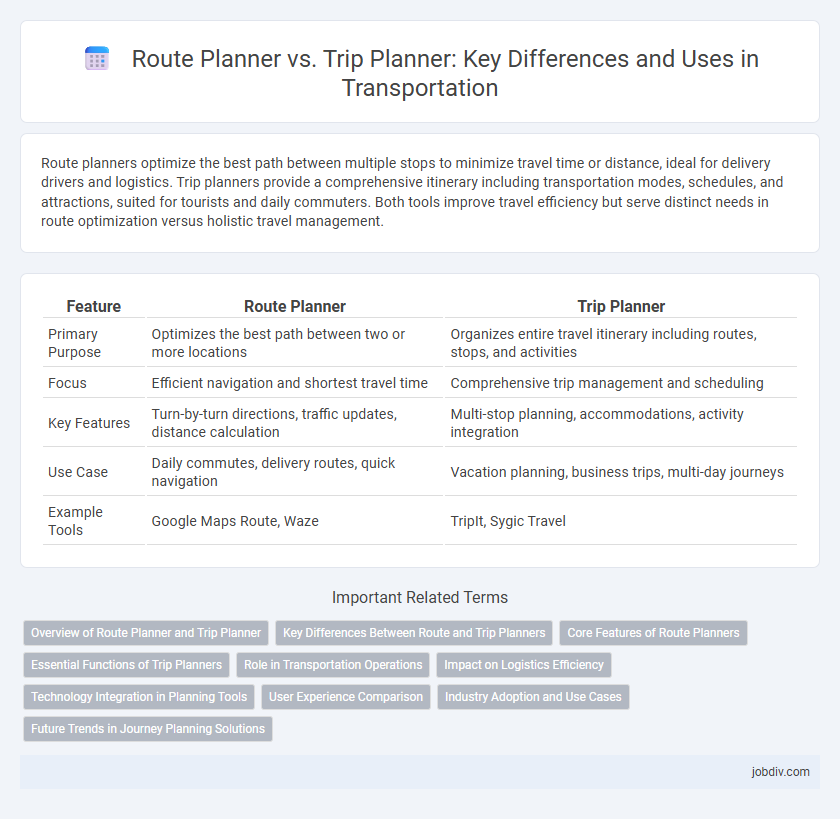Route planners optimize the best path between multiple stops to minimize travel time or distance, ideal for delivery drivers and logistics. Trip planners provide a comprehensive itinerary including transportation modes, schedules, and attractions, suited for tourists and daily commuters. Both tools improve travel efficiency but serve distinct needs in route optimization versus holistic travel management.
Table of Comparison
| Feature | Route Planner | Trip Planner |
|---|---|---|
| Primary Purpose | Optimizes the best path between two or more locations | Organizes entire travel itinerary including routes, stops, and activities |
| Focus | Efficient navigation and shortest travel time | Comprehensive trip management and scheduling |
| Key Features | Turn-by-turn directions, traffic updates, distance calculation | Multi-stop planning, accommodations, activity integration |
| Use Case | Daily commutes, delivery routes, quick navigation | Vacation planning, business trips, multi-day journeys |
| Example Tools | Google Maps Route, Waze | TripIt, Sygic Travel |
Overview of Route Planner and Trip Planner
A Route Planner specializes in calculating the most efficient path between multiple points, optimizing travel time and distance based on real-time traffic data and road conditions. Trip Planners provide a broader scope by integrating itinerary details such as transportation modes, accommodation, and activity scheduling for a comprehensive travel experience. Both tools leverage GPS and mapping technologies but serve distinct functions in trip optimization and logistics management.
Key Differences Between Route and Trip Planners
Route planners optimize the best path between multiple stops based on criteria like shortest distance or fastest travel time, primarily focusing on navigation efficiency. Trip planners encompass a broader scope, integrating scheduling, transportation modes, and activities to create comprehensive travel itineraries. Key differences include route planners' emphasis on routing algorithms and traffic conditions, while trip planners prioritize time management, booking options, and multi-modal transport coordination.
Core Features of Route Planners
Route planners specialize in calculating the most efficient paths between multiple destinations using algorithm-driven optimization, incorporating real-time traffic updates and route preferences such as avoiding tolls or highways. Their core features include turn-by-turn navigation, multi-stop routing, and integration with GPS for live location tracking. Unlike trip planners that emphasize itinerary creation and activity scheduling, route planners prioritize accuracy in distance, travel time estimation, and route customization to streamline transportation logistics.
Essential Functions of Trip Planners
Trip planners specialize in optimizing travel itineraries by integrating various transportation modes, schedules, and real-time traffic data to deliver personalized routes. They provide essential functions such as calculating total trip duration, suggesting cost-effective options, and offering alternative routes based on user preferences. Unlike route planners that primarily focus on navigation from point A to B, trip planners enhance overall travel efficiency by coordinating connections between flights, trains, buses, and other transit services.
Role in Transportation Operations
Route planners optimize the sequence of stops and paths for vehicles to minimize travel time and fuel consumption, directly enhancing operational efficiency in logistics and delivery services. Trip planners facilitate passenger movement by integrating multiple transportation modes and schedules to provide the most convenient and time-effective travel options. Both tools play critical roles in improving overall transportation system performance but target distinct operational aspects: route planners focus on fleet management, while trip planners emphasize user-centered travel experience.
Impact on Logistics Efficiency
Route planners optimize the sequence of stops and paths for vehicles, reducing travel time and fuel consumption, which directly improves logistics efficiency. Trip planners focus on scheduling and integrating multiple transport modes, ensuring timely deliveries and effective resource allocation. Combining both tools minimizes delays and operational costs, significantly enhancing supply chain performance.
Technology Integration in Planning Tools
Route planners leverage GPS technology and real-time traffic data to optimize more efficient travel paths, minimizing delays and fuel consumption. Trip planners integrate broader datasets such as public transit schedules, accommodation options, and activity recommendations, offering a comprehensive itinerary solution. Advanced algorithms in both tools utilize machine learning to enhance prediction accuracy and personalize travel experiences based on user preferences.
User Experience Comparison
Route planners emphasize finding the most efficient path between locations using real-time traffic data and navigation features, ensuring quick and reliable directions. Trip planners offer a broader scope by integrating multiple transportation modes, scheduling options, and destination insights to enhance overall travel convenience and itinerary management. Users experience route planners as straightforward for immediate navigation, while trip planners provide a comprehensive approach for complex journeys and multi-stop trips.
Industry Adoption and Use Cases
Route planners are widely adopted in logistics and delivery industries for optimizing shortest paths and reducing fuel costs through real-time traffic data integration. Trip planners find extensive use in public transportation and tourism sectors where multi-modal travel options and personalized itinerary creation are critical. Both tools enhance operational efficiency, but route planners emphasize route optimization while trip planners prioritize comprehensive journey management.
Future Trends in Journey Planning Solutions
Route planners leverage real-time data and AI-driven algorithms to optimize the fastest or shortest paths, while trip planners integrate multimodal transportation options, including ridesharing, public transit, and micromobility, for seamless end-to-end journeys. Emerging trends highlight the adoption of predictive analytics and machine learning to personalize travel itineraries based on user preferences, traffic patterns, and environmental impact. Future journey planning solutions will emphasize sustainability, augmented reality interfaces, and blockchain for secure, transparent ticketing and payment systems.
Route Planner vs Trip Planner Infographic

 jobdiv.com
jobdiv.com